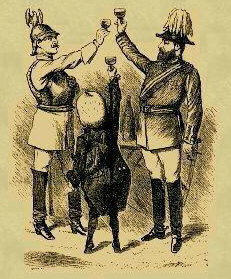the Honourable Mrs George Keppel
On February 27, 1898, Bertie had dinner for the first time in the residence of Hon. George Keppel and his
29-year-old wife, Alice, who was the daughter of Admiral Sir William Edmonstone. The Prince was immediately
attracted by the talent and grace of his hostess and it was enough to begin a passionate relation that would
last until Bertie's death. George Keppel accepted the relationship and soon Alice was shown everywhere in Bertie's
company. Because of her qualities and discretion she was welcome almost everywhere they went, in England and
in the Continent.
Alix tolerated Mrs. Keppel. She was displeased with the fact that Alice Keppel appeared everywhere Alix and Bertie went. She was in the yacht races at Cowes, in Biarritz for Bertie's winter holidays or in Marienbad where the Prince attended for his annual cure. Nevertheless, the Princess was was grateful to Alice for keeping Bertie entertained, good tempered and far for boredom which haunted him permanently; she used to laugh at her husband and his lover while watching them sitting side by side, since they were both quite plump while Alix, twenty five years the senior of Mrs. Keppel, had always a slim figure
At a dinner at Crichel in December 1907, not attended by Bertie, Mrs Keppel was placed next to his nephew and enemy Kaiser William II of Germany so `she might have the opportunity of talking to him'. The Austrian Ambassador, Count Mensdorff, a second cousin of Bertie's, wondered `what sort of report she sent back to Sandringham'. Alice got on well enough with the Kaiser to send him, care of the German Embassy in Carlton House Terrace, a photograph of a new portrait of herself. It showed her with plunging neckline, flicking at her pearls.
Group photographs of huge shooting parties commemorate Mrs Keppel's weekends with Bertie. He sits at the centre, portly and assured, Homburg tilted, hands folded on his walking stick, flanked by ladies in ankle-length gowns, their hats like nesting birds. All look inscrutably at the camera. Nothing is revealed of the secret relationships between other women's husbands and other men's wives, of the elaborate games of adultery decorously conducted at these country-house weekends. |

|
 From left to right - Back row: Hon. P. Thelusson and Hon Mrs George Keppel Front Row: Princess Victoria and Lady Alington Seated on the ground: Lois Sturt (daughter of Lady Alington)
This painting by Sir Gerald Kelly show what a beautiful woman she was. |
Mrs Kepple is seen in one such picture taken at Crichel in 1909 a small part of which is reproduced on the left. Included with the party are the King and Queen with Princess Victoria and the Alingtons, Lord Farquhar, the Countess of Gosford, Marquis de Soveral, the Earl and Countess de Grey, Lady Bass and others.
Before her relationship with the King, MrsKeppel had been the mistress of Lord Alington. Also in the photograph is a very young Lois Sturt. In later years she would have an affair with Price George (who would become King George VI). He had a mind to marry her but her "fast" reputation had doomed them in the eyes of the King (Edward VII). The sauce of the goose could obviouly not be that of the gosling! The housekeeper, maids and valets at the weekend gatherings understood the careful coding of the cards that hung beside the bell indicator outside the pantry and `the recurrence of certain adjustments and coincidences'. At times scandal surfaced -- to do with jealousy, betrayal, broken hearts. The Prince of Wales was twice threatened with the law by angry husbands. But these elite gatherings were untroubled by intrusion from zoom-angle lenses through the windows of the Tapestry Room, the tapping of cellular phones or bugging devices in the chandeliers. Mrs Keppel turned adultery into an art. Her demeanour and poise countered `whispers, taints and horrible noxious suspicions'. Clear as to what she wanted -- prosperity and status -- she challenged none of the proprieties of her class. She remained with the King until his death. |
|
| References: Diana Southami, Mrs. Keppel and Her Daughter, New York: St. Martinís Press, 1997 Sarah Bradford, King George VI, Weinenfeld and Nicholson, London, 1989. |
||
 The Hon. Lois Sturt (1900-1937), later Lady Tredegar, was an actress, born on 25 August 1900. She was the daughter of Humphrey Napier Sturt, 2nd Baron Alington (1859-1919) and Lady Feodorowna Yorke (died 1934). She became the lover of Reginald, 15th Earl of Pembroke, and of Prince George, the Duke of Kent. She married Evan Morgan, 2nd Viscount Tredegar (1893-1949) in 1928, and died of a heart attack on 18 September 1937.
The Hon. Lois Sturt (1900-1937), later Lady Tredegar, was an actress, born on 25 August 1900. She was the daughter of Humphrey Napier Sturt, 2nd Baron Alington (1859-1919) and Lady Feodorowna Yorke (died 1934). She became the lover of Reginald, 15th Earl of Pembroke, and of Prince George, the Duke of Kent. She married Evan Morgan, 2nd Viscount Tredegar (1893-1949) in 1928, and died of a heart attack on 18 September 1937.